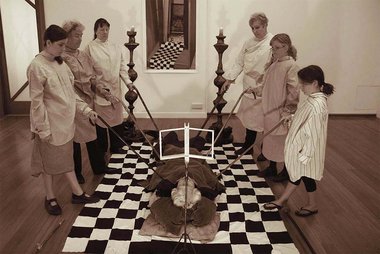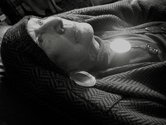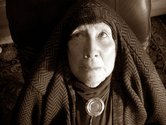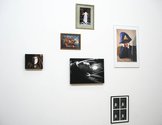Andrew Paul Wood – 29 April, 2013
Though these tableaux are posed, they still invoke the sorrows, sweetness, and the ambivalence that is part of intimacy. Because Dawson's actors come from the beginning and end of the human lifespan, they are able to offer a wonderfully uninhibited interiority, awkwardness and eloquence.
Christchurch artist Margaret Dawson’s latest body of work is deeply imbued with the nature of ritual and mystery. With friends and family as models and collaborators, Dawson investigates the connections between some of the ways human beings use to re-enchant or make liveable the mundane reality of life. Ritual manifests itself in many ways in these photographs; in allusion to Masonic rites, Christian symbolism, contemporary and historical art, and even the repetitive physical exercises of elder care. Ritual acts raise us closer to the transcendental.
“Tree arising! Oh pure transcendence!
Oh Orpheus Sings! Towering tree in the ear!
Everywhere stillness, yet in this silence:
New beginnings beckon, change is near.” - Rainier Maria Rilke, Die Sonette an Orpheus, I: I (translation mine)
All of this hints at a ritual story-quest of challenge, transformation, and initiation into some powerful mystical secret - like the chequered cloth that represents the difficult path for the Entered Apprentice in Freemasonry, or the obvious the fragilities of age - the act of viewing these images is to enter the Chapel Perilous and be invited to discover something about ourselves.
Thematically Dawson’s oeuvre often resembles a record of an amateur performance of an unknown play, or a group of children imitating some mysterious aspect of the adult world they don’t quite understand with a combination of naïve awe and workaday practicality. And yet the actors seem to know more about what is going on in the images than the audience does - a cunning reversal of roles. Settings seem improvised, make do, which gives each scene the aura of authenticity. We get the sense that we are touching the hem of a secret. The simplicity of the props and the amateur actors - Dawson’s elderly mother is one of the more apparent collaborators (recalling a similar collaboration with Dawson’s uncle in The Men from Uncle) - suggests an undermining or subversion of the high seriousness of the rituals and perhaps the masculine world they represent.
Like a mystery cult or a secret society, Dawson’s photographs hint at a fully formed syntax that the audience is not, and may never be privy to, but the symbolism is handled with the lightest of touch and encompasses all of the significant cycles of human existence: life and death, youth and age, public and secret, the mystical and the mundane. These great cosmic verities are visually encoded in tableaux constructed in a vocabulary of the found and the ordinary. A particular theatrical magic is conjured from the most commonplace sources, spiced up with moments of specific wit.
What are we looking at? What is happening? The work seems to invite the viewer to make their own interpretations of the mysteries. Dawson asks difficult, self-conscious questions about how the unflinchingly realistic eye of the camera lens may interact with the mystical experience, the role of the auteur, the instinct to be included and involved, and the sacred and profane. The American philosopher Richard Rorty coined the name “ironic pragmatism” for his notion that to conceive of human thought as a teleological approach to discovering the ultimate Truth was false. The Truth itself was irrelevant, and possibly didn’t even exist, à la Wittgenstein, in a knowable form. Dawson’s photographs function analogously as propositions:
“Propositions cannot represent logical form: it is mirrored in them.
What find its reflection in language, language cannot represent.
What expresses itself in language, we cannot express by means of language.
Propositions show the logical form of reality.
They display it.” - Ludwig Wittgenstein, Tractatus Logico-Philosophicus (4.121)
Rorty suggested that perhaps the goal of human thought was not this “Truth”, but rather to understand the various paths human beings take in the attempt to find it. To an extent, Dawson’s work conforms to this interest in the multiple paths and byways of art, philosophy and belief. Dawson offers her subjects in elliptical, poignant glimpses, and the visual economy of her photographs is such that the dream-like near-familiarity of the settings, the sometimes obscured figures, and the possibility of what might be outside the frame, only serves to heighten the sense of mystery. Because the images are so allusive and emotionally tense, they make active use of sentimentality - a feminist and feminine rejection of modernist tropes. Dawson is not afraid to explore the nostalgic folksy clichés of childhood play and the frailty of palliative old age - such explorations require a sense of passion, compassion, a maturity that goes beyond mere adolescent cynicism, and a comfortable command of one’s visual vocabulary in an art world dominated by the conceptual or spectacle. It is an act of love.
Mixed in with this powerful brew is a strongly gothic sensibility of disorienting characters, decayed settings, and sinister, alienating situations in order to better understand contemporary social and cultural values in magical realist scenes that are both mythic and familiar. These are poetic fictions, not documents - though a sense of the photograph as social record exists as a faint and fading echo. Though these tableaux are posed, they still invoke the sorrows, sweetness, and the ambivalence that is part of intimacy. Because Dawson’s actors come from the beginning and end of the human lifespan, they are able to offer a wonderfully uninhibited interiority, awkwardness and eloquence.
The history of the occult forms an important touchstone to this suite of images and allows Dawson to mine historical images to reiterate as templates. The Masonic allusions are obvious - the checkered cloth leading like a path through a secret door to a reproduction of one of Julia Morison’s Kabbalistic paintings, the prone figure on the floor surrounded ringed by sticks symbolising swords being pointed. We also find a deliberately crude and comedic facsimile of the well known portrait of arch-diabolist Aleister Crowley, the Great Beast, face on fists and in silly ceremonial hat. Another image reproduces the equally well known photographic portrait of Madame Blavatsky, founder of Theosophy.
Another image has Dawson’s mother horizontal, in Gypsy-ish garb, but her jewelry is actually the lids of tin cans - a reference to earlier installation work by the artist where cleaned and polished tin cans were the primary medium. Two more images playfully counterpoint mysterious esoteric sigils with child-like drawings of flowers and tea cups. Any suggestion of the overly portentous or pretentious is quickly subverted, including those of art itself. It is work that grabs you up and pushes your emotional self beyond the limits of self-consciousness. It offers, if not an epiphany, a glimmer of what intimacy, sentiment, and mystery really mean in a world saturated with disposable visual banalities, clichés, kitsch, marketing, media, and hollow consumer capitalist excess.
Andrew Paul Wood










 Two Rooms presents a program of residencies and projects
Two Rooms presents a program of residencies and projects Advertising in this column
Advertising in this column



This Discussion has 0 comments.
Comment
Participate
Register to Participate.
Sign in
Sign in to an existing account.